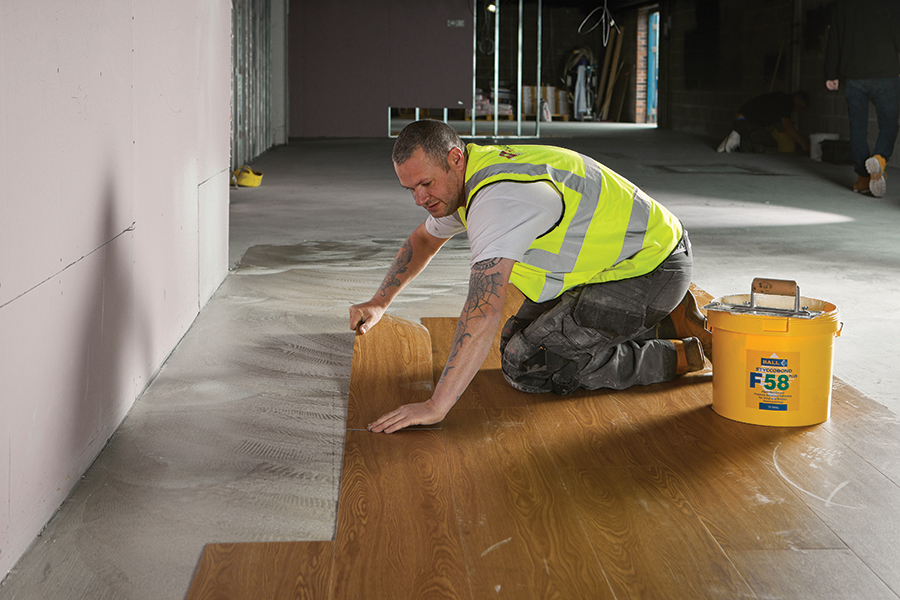F BALL AND CO’s ‘System LVT’ range comprises waterproof surface membranes, primers and smoothing compounds which, used correctly and in combination, guarantee an ‘aesthetically pleasing, durable floor finish’ when installing LVTs, says the company. This is supported by the F. Ball guarantee, which states the company will fund the replacement of the entire flooring installation in the event of a floor failure in these circumstances.
First steps
The first step in any flooring installation should be to check the subfloor is suitably sound, smooth and dry. To avoid costly floor failure, any laitance and contaminants should be mechanically removed before proceeding with a flooring installation, says the company.
Where subfloor Relative Humidity (RH) levels are higher than 75%, a moisture management solution will be required to prevent moisture attacking flooring adhesives and causing resilient floorcoverings to blister and lift.
Moisture management
F. Ball’s System LVT range is said to include the company’s high-performance waterproof surface membranes. F. Ball’s Stopgap F77 will isolate excess subfloor moisture where RH values are up to 98%, with a single coat application, which is said to fully cure from three hours.
Stopgap F78 is said to create a barrier against residual construction moisture, where relative humidity values are up to 95%, with two coats. The first coat cures in 15-20mins. A further 30mins curing time is required for the second coat.
Priming
In most cases, the next step in the subfloor preparation process should be to prime the subfloor. When used over non-absorbent surfaces, such as waterproof surface membranes, primers are said by F Ball to promote adhesion between the subfloor and the smoothing compound applied over it. Applied over absorbent subfloors, they also stop the unacceptably rapid drying of smoothing compounds.
Priming is also said to prevent ‘pinholing’. These are small holes in the smoothing compound that have the appearance of pinholes or blisters caused by the slow escape of air from absorbent surfaces as the smoothing compound cures.
Stopgap P131 is described by the company as F. Ball’s general-purpose primer, recommended for absorbent surfaces as part of the System LVT range. The company adds: ‘F. Ball’s Stopgap P141 is formulated for use over non-absorbent surfaces, and Stopgap P121 promotes the application characteristics of compatible smoothing compounds when applied over calcium sulphate screeds.’
Creating a base
A smoothing compound should then be applied over the subfloor to create a smooth and level surface onto which LVTs can be installed. This ensures the visual appearance of the floorcovering is flawless and not compromised by imperfections in the subfloor showing through.
The company explains: ‘In heavy-duty areas, where installations will be subject to heavy loads or high-foot traffic, the use of a heavy-duty smoothing compound, such as F. Ball’s Stopgap 300 HD, is recommended. The high compressive strength and self-smoothing properties of these smoothing compounds will create the perfect base for the installation of LVTs.’
When working over subfloors of plywood or steel, the application of F. Ball’s Stopgap 700 Superflex flexible smoothing compound is advised to accommodate movements in the subfloor.’
Where an LVT installation is part of a refurbishment and old adhesive residues are present after the removal of old floorcoverings, F. Ball’s Stopgap 1200 Pro is said to provide a time saving solution. F Ball adds: ‘The fast-setting, fast-drying smoothing compound can be applied straight over old adhesive residues, without the need to prime beforehand, removing the need for mechanical preparation. Normally adhesive residues need to be fully removed before applying a smoothing compound.’
Adhesive selection
Pressure sensitive adhesives, such as F. Ball’s Styccobond F46, are often the best choice for installing vinyl tiles or planks, says the company. They’re said to form an instant grab upon contact, so contractors don’t need to worry about tiles or planks moving about when they’re working, making them ideal for where intricate designs or patterns are being created.
Temperature tolerant adhesives have been developed for installing floorcoverings in areas exposed to high temperatures, which can cause vinyl floorcoverings to move significantly and lead to unsightly tenting and gapping at the edge of LVTs over time, explains F Ball.
It will often be desirable to have the advantages of other kinds of adhesives. In addition to Styccobond F46, F. Ball’s ‘System LVT’ range features adhesives for vinyl floorcoverings that combine several specialist attributes, including pressure sensitive, moisture resistant and temperature tolerant characteristics, says the company.
Compatibility check
Finally, it’s highly recommended that contractors always check the compatibility of floorcoverings and adhesives. To do this, you can consult the floorcovering manufacturer’s guidelines, says the company. Alternatively, F. Ball produces its Recommended Adhesives Guide (RAG), which lists adhesives recommended for use with over 6,000 floorcoverings produced by over 200 manufacturers, for this purpose. It concludes: ‘A continuously updated version of the RAG is available as a free app and on the F. Ball website. It’s also available as an A5 printed booklet, free copies of which can be requested from F. Ball. Alternatively, contractors can contact F. Ball’s technical service department, from 8.30am–5.00pm, Monday to Friday, for advice on adhesive compatibility’.
www.f-ball.com
Please click to view more articles about
> F Ball <

